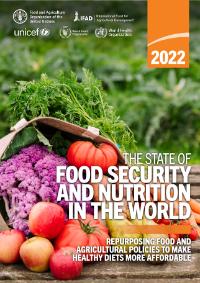
The Russian Federation and Ukraine are among the most important producers of agricultural commodities in the world. Before the crisis, the two countries together supplied 30 per cent and 20 per cent of global wheat and maize exports, respectively. They also accounted for close to 80 per cent of global exports of sunflower seed products. Furthermore, the Russian Federation is a world-leading exporter of nitrogen, potassium and phosphorous fertilizers, whose prices have been increasing since late 2020 because of rising energy prices as well as rising transportation costs in the wake of the COVID-19 pandemic.
The disruptions to agricultural exports caused by the war in Ukraine have exposed global food and fertilizer markets to heightened risks of tighter availabilities, unmet import demand and higher international prices. Many countries that are highly dependent on imported foodstuffs and fertilizers, including numerous that fall into the groups of least developed countries (LDCs) and low-income food-deficit countries (LIFDCs), rely on Ukrainian and Russian food supplies to meet their consumption needs. Many of these countries, already prior to the conflict, had been grappling with the negative effects of high international food and fertilizer prices.
In Ukraine, the escalation of the conflict raises concerns over whether crops will be harvested and products exported. There is also uncertainty surrounding Russian export prospects, because of sales difficulties that may arise as a result of financial and shipping constraints. Such export shortfalls are likely to elevate already high world food commodity prices even further.
From a regional perspective, vulnerable populations in sub-Saharan Africa and the Near East and North Africa are the most at risk of increased undernourishment due to the conflict.
Also read: A critical juncture for global food security
The low-income level, associated with the high shares of food expenditure in sub-Saharan Africa, and the particularly high dependency of the Near East and North Africa diets on imported wheat, especially from Ukraine and the Russian Federation, make poor consumers extremely vulnerable to wheat, maize and vegetable oil price shocks.
Besides the direct impact on global food supplies, the conflict poses a number of additional risks that will also impact agricultural production and trade.
As a highly energy-intensive industry, especially in industrialized regions, agriculture will inevitably be affected by the sharp increase in energy prices. With the prices of fertilizers and other energy-intensive products rising as a consequence of the conflict, overall input prices are expected to experience a considerable hike. The higher prices of these inputs will first translate into higher production costs and eventually into higher food prices.
They could also lead to lower input use levels, reducing global crop production, thus giving further upside risk to the state of global food security in the coming years.
The conflict and the subsequent economic sanctions against the Russian Federation are also likely to impact exchange rates, debt levels and overall economic growth prospects. In April 2022, the IMF released its World Economic Outlook, with global growth projected to slow down from an estimated 6.1 per cent in 2021 to 3.6 per cent in 2022 and 2023 because of the war. This represents 0.8 and 0.2 percentage point lower for 2022 and 2023, respectively, than projected in January 2022. The IMF expects a severe double-digit drop in GDP for Ukraine and a large contraction in the Russian Federation, which can have worldwide spillover effects through commodity markets, trade, remittance flows and financial channels.
Reduced GDP growth in several parts of the world will affect global demand for agrifood products. Furthermore, a lasting appreciation of the USD, especially in the context of rising interest rates in the United States of America, may have significant economic consequences for developing regions and increase their debt burdens.
All of this comes at a time when the world is still attempting to recover from the recession triggered by the COVID-19 pandemic.
It is projected that nearly 670 million people will still be undernourished in 2030 – 8 per cent of the world population, which is the same proportion as in 2015 when the 2030 Agenda was launched. This is 78 million more undernourished people in 2030 compared to a scenario in which the pandemic had not occurred. The projected gradual reduction in global hunger by 2030 is largely due to the significant improvements foreseen for Asia, where the number of undernourished people (NoU) is projected to fall from the current 425 million to around 295 million (equivalent to about 6 per cent of the population), and to a simultaneous worsening in Africa, where the NoU is projected to grow from almost 280 to more than 310 million (corresponding to slightly above 18 per cent of the population). For Latin America and the Caribbean, the number of people affected by undernourishment is projected to remain stable until 2030 at around 56 million (which corresponds to about 8 per cent of the population).

*Excerpted from The State of Food Security and Nutrition in the World 2022 jointly published by FAO; IFAD; UNICEF; WFP; WHO.





